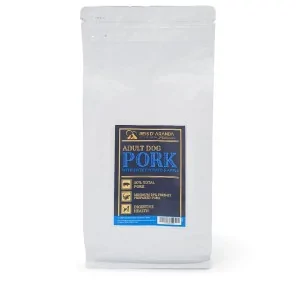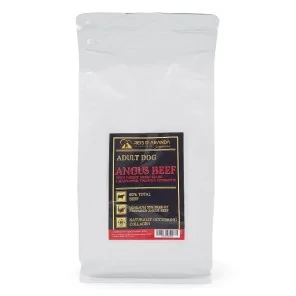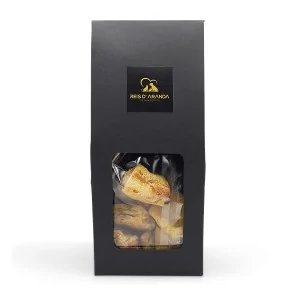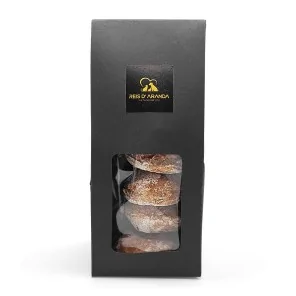The Tornjak originated from genetically homogeneous, almost extinct, indigenous shepherd dogs. These dogs have...
THE FILA BRASILEIRO
INTRODUCTION
This breed may not be well known in our country, but in Brazil and much of Latin America it is one of the most loved and sought after dogs. The Fila Brasileiro is capable of performing many important tasks, from protecting farms from settlers to guiding retinues through the country so that they would not be eaten by jaguars.
THE HISTORY OF THE FILA BRASILEIRO
The fila brasileiro is not a man-made breed but has evolved naturally due to the need of the early settlers in Brazil for a vigorous and energetic working dog. These early filas can be seen in historical documents dating back to 1671. The exact origins of these early filas are unknown.
However, most people agree that the fila brasileiro is a combination of three basic breeds: the old bulldogs, the mastiff and the bloodhound. Some also believe that the fila terceirense was also involved in the creation and development of the fila brasileiro.
One of the breeds that contributed to its creation was the engelsen doggen. These ancient bulldogs were frequently used for hunting and fighting. They were brought to Brazil during the Dutch invasion, around 1630. From the Engelsen doggen the fila brasileiro inherited their ageing temperament, their stubbornness and tenacity.
Some of the physical traits that these ancient bulldogs share with today's fila brasileiro are the raised ears, the coat colours and a croup higher than the withers, which is one of their distinguishing features.
The influence of the English Mastiff is clearly visible. From these large and fierce dogs, the fila got its size and substance. These ancient mastiffs, often used in battle and hunting, also transmitted to the fila brasileiro the large, strong head, the short neck and the curved croup. The mastiff and the fila brasileiro share the same basic coat colours and also the black mask.
The Bloodhound was imported to Brazil in the early 19th century because of its excellent reputation as a tracking dog. The Bloodhound passed on to the Brazilian fila its excellent abilities as a tracking dog. The abundance of loose skin, pendulous lips and pendulous upper lips, obvious characteristics of the bloodhound, can also be seen in the fila. Anyone who owns one can tell you that bloodhound vocalisations are present in today's fila. Many fila owners claim that their dogs have a language of their own.
Another theory speculates that a fourth breed collaborated in the formation of the Brazilian fila. This would be the fila terceirense, a shepherd dog that was brought by Portuguese settlers from the Azores Islands. This would explain its ability to herd cattle and perhaps also a trait that is sometimes seen in filas, which consists in the tail being twisted in such a way that it changes its direction to one side. This physical characteristic is the reason why the fila is called ‘crooked tail’ or ‘broken tail’ in Brazil, its country of origin.
Around 1930, the German Mastiffs were becoming very popular in Brazil. Although the fila, as a breed, was well established by this time, some breeders tried to introduce blood from the German Dogo into the fila brasileiro. These crosses were not numerically important and did nothing for the improvement of the breed. By this time it was realised that trying to add new breeds to the fila brasileiro could only harm, not improve, its balanced temperament.
In 1968 Dr. Erwin Rathsam, together with Dr. Paulo Santos Cruz and Dr. Joao Ebner wrote the first official breed standard. Up to this time, the fila brasileiro was considered only as a working breed. At that time the first filas were shown in Brazil and judged according to the new standard. Not all filas participated in the show rings. Many of them continued to perform their duties as working dogs. These dogs did not even have a pedigree. They were bred solely for their usefulness.
The Fédération Cynologique Internationale (FCI) recognised the fila brasileiro breed in 1968. The standard was introduced throughout Europe, including England, Holland and Italy and remained unchanged for almost a decade. But in 1976, the first fila brasileiro symposium was held in Brazil and the standard was revised. The fila brasileiro continued to grow in fame until 1982, when it became the most popular breed in Brazil, with 8087 puppies registered in one of Brazil's stud books.
In 1983 a large national congress was held in Rio de Janeiro. Its aim was to determine the breeding practices of the fila brasileiro and to talk about revisions for the breed standard. As a result of this meeting a more detailed standard was obtained, which was published on January 1st 1994 and is still in force today.
WHAT IS THE FILA BRASILEIRO LIKE?
GENERAL APPEARANCE: Typical Molossian breed. Powerful bone structure, rectangular and compact, yet harmonious and well proportioned. Presents, together with its body mass, a great concentrated and easily perceptible agility. Sexual dimorphism should be very well defined and obvious (female dogs, male dogs).
IMPORTANT PROPORTIONS:
- Muzzle slightly shorter than the skull.
- The length of the body, measured from the point of the sternum to the point of the buttock, exceeds the height at the withers by 15%.
HEAD: Large, heavy, massive, but always well proportioned to the body. Seen from above, it resembles a trapezium into which the pear-shaped head has been inserted.
CRANIAL REGION:
SKULL: The profile of the skull has a gentle curve, extending from the nasolabial depression to the occipital protuberance, which is marked and protruding, especially in puppies. From the front, it is broad with a curved topline. Its lateral lines descend in shallow curves, almost vertically, and taper towards the muzzle in a continuous line.
STOP: Seen from the front, it is practically non-existent. The median furrow rises gently almost to the middle of the skull. Seen from the side, it is not very marked, sloping and almost formed by the well developed superciliary arches.
FACIAL REGION:
TRUFFLE: Nostrils, broad, well developed, but not occupying the full width of the jaw. Black in colour.
HOCIO: Strong, broad, prominent, always in proportion to the skull. Of good prominence at the base, without being higher than long. Seen from above, well filled under the eyes and tapering very slightly to the middle, then widening slightly to the front curve. Seen in profile, the muzzle has a straight or slightly arched upper line, but never upward. The front line is almost perpendicular to the muzzle, with a slight depression just below the nose.
BELPHOS: The upper lip is thick and pendulous and covers the lower lip in a perfect curve: the lower line of the muzzle is thus almost parallel to the upper line. The lower lip is well applied up to the region of the fangs; from there it is loose to the back, with ‘jagged’ edges, and ends with the corner of the mouth always apparent. The edge of the lips forms a deep inverted U-shape.
TEETH: The teeth are characteristically wider than long. They are strong and white. The upper incisors are broad at the root and sharp at the edges. The canines are strong, well set in the jaw and set wide apart. The ideal articulation is scissor bite.
EYES: Medium to large, almond-shaped, set wide apart and medium to deep set. Their colour ranges from brown to yellow, always in harmony with the colour of the coat. However, a darker colour is preferred. Due to the loose skin, many dogs have hanging eyelids, which should not be considered a fault, as this accentuates the sad look typical of the breed.
EARS: Hanging, thick, large, V-shaped, broad at the root, tapering towards the rounded tips. Set on the back of the skull, they are set at the level of the midline of the eyes when the dog is at rest and rise above the primitive ligament when the dog is attentive. The ears are inclined in the ligament, the front edge being higher than the rear edge. They are presented hanging to one side or folded back, so that their interior is visible (pinkish in colour).
NECK: Extraordinarily strong and muscular, appearing short. The upper edge is slightly convex, well separated from the skull. Presence of dewlap.
BODY: Strong, broad and high trunk, covered with thick, loose skin. The thorax is longer than the abdomen.
Height at withers is slightly lower than the croup, in a descending line, broad, due to the separation of the shoulder blades. At the point where the withers end, the topline changes direction, rising smoothly to the front of the croup, without any sign of a sloping or arched back (carpal back).
LOIN AND FLANCO: Less long and broad than the chest. They are clearly separated. In the female, the edge of the flank is more developed. Seen from above, the loin should be less broad and full than the chest and croup, but without showing signs of narrowness.
Croup: Broad, long, its obliquity approaching 30 degrees to the horizontal and ending in a gentle curve. Slightly higher than the withers. Seen from behind, it should be broad, of almost equal width to that of the chest, and may be even broader in bitches.
CHEST: The ribs well sprung, but without affecting the position of the shoulders. The chest is broad and well laid back, reaching to the point of the elbows; the pectorals are well sprung.
BOTTOM LINE AND BELLY: The chest is long and parallel to the ground throughout. The belly rises smoothly and is never sloping.
TAIL: Broad at root and medium set on. It quickly becomes thinner and ends at the level of the hock. When the dog is excited, the tail rises, accentuating the curvature of the limb. The tail should not fall over the back, nor curl up.
LIMBS
FOREQUARTERS:
GENERAL APPEARANCE: The height of the foreleg from the elbow to the ground should be equal to the height from the elbow to the withers.
Shoulders: The shoulder and upper arm should consist of two bones of equal length, scapula and humerus. The scapula forms an angle of 45° to the horizontal and the humerus approximately 90° to the scapula. The scapula-humeral joint forms the point of the shoulder, which should be at the level of the tip of the sternum, a little behind the sternum. Ideally, the shoulder and arm should be located in the space from the withers to the sternum, and the end of the shoulder should be located midway along this trajectory. An imaginary perpendicular descending from the withers should pass through the elbow to the foot.
FOREARM: The limbs should be parallel. Bones strong and straight.
CHEEKS: Strong and apparent.
METACARPERS: Short, slightly sloping.
HANDS: Strong, well arched fingers, but not too close together. The support is on thick fingers and broad, long and thick pads. In the correct position, the fingers should be pointing forward. The nails are strong, dark, and may be white when the corresponding toe is also white.
HIND LEGS:
GENERAL APPEARANCE: The bones are not as thick as those of the forelegs, however, as a whole, they should never appear thin. The hindquarters are parallel.
THIGH: Broad, with arched edges, as they are formed by the muscles descending from the ilium and ischium. They shape the curve of the buttock, hence the need for a good sized ischium.
TARSI: Strong.
METATARS: Slightly sloping, longer than the pasterns; the angulation of the stifle and hock is moderate.
FEET: Slightly more oval than the fore feet and similar in all other respects. Dewclaws should not be present.
GAIT / MOVEMENT: Long, elastic gait, like that of felines. Its main characteristic is the movement of the two limbs on one side, then passing to the two limbs on the other side, ‘camel gait’. This produces a waddle, with a lateral swinging of the thorax and haunches, accentuated by the tail when it is raised. When the dog is in stride his head is held below the dorsal line. The trot is easy, harmonious, loose, with wide, powerful strides covering the ground well. The gallop is powerful and with it the dog reaches a speed unsuspected for such a large and heavy animal. His movement is always influenced by the typical molosser joints, which not only give the impression, but actually allow sudden and rapid changes of direction.
SKIN: One of the most important characteristics of the breed is that the skin should be thick and loose over the whole trunk, mainly over the neck, where it forms pronounced dewlaps, which in many cases, reach down to the chest and abdomen. Some dogs have a crease on the sides of the head and another crease running down from the withers to the shoulder. In repose, the head should show no folds; when the dog is alert, the contraction of the skin of the skull, which is formed when the dog raises his ears, causes small longitudinal folds to appear between the ears on the skull.
COAT: Short, dense, soft and well stretched over the body.
COLOUR: brindle, fawn and black. A black mask may or may not be present. In all permitted colours there may be white markings on feet, chest and tip of tail. White markings on other parts of the coat are considered as fault.
SIZE AND WEIGHT:
HEIGHT AT WITHERS:
MALES: 65 to 75 cm
FEMALES: 60 to 70 cm
WEIGHT: Minimum 40 kg for bitches. Minimum 50 kg for males.
FAULTS: Any departure from the foregoing points should be considered a fault and the seriousness with which the fault should be regarded should be in exact proportion to its degree and its effect upon the health and welfare of the dog.
- Level bite.
- Short muzzle.
- Small ears.
- Ears carried high.
- Excessively light eyes.
- Presence of folds while the dog is at rest.
- Undershot underbite.
- Double chin (fold in the skin in front of the dewlap).
- Crouching back.
- Very narrow croup.
- Tail carried curled over the back.
- Slightly sloping chest.
- Metatarsus and metacarpus markedly deviated.
- Very angulated hind pasterns.
- Short stride.
SERIOUS FAULTS:
- Apathy and shyness.
- Square silhouette.
- Small head.
- Pronounced nasolabial depression, seen from the front.
- Short upper lip.
- Bulging eyes.
- Round eyes.
- Poor pigmentation of the eyelids.
- Absence of 2 teeth except PM1 (premolars 1) or first premolars.
- Absence of dewlap.
- Arched back.
- Horizontal topline.
- Excessively raised lower line.
- Light bone.
- Lack of substance.
- Cow hocks.
- Lack of angulation of the hind legs (‘pig's foot’).
- White markings covering more than a quarter of the body.
- Size above the maximum required.
DISQUALIFYING FAULTS:
- Aggressiveness or extreme shyness.
- Any dog showing clear signs of physical or behavioural abnormalities.
- Pink nose.
- Overshot.
- Undershot mouth leaving teeth visible, even if muzzle is closed.
- Lack of tusk or one molar (except M3).
- Bluish eyes (eyes of a different colour).
- Cropped ears or tail.
- Croup lower than withers.
- Dog showing no ambling.
- Absence of loose, elastic skin.
- All dogs white, mouse grey, mottled, black and tan, and blue.
- Males less than 65 cm and bitches less than 60 cm height at withers.
- Cryptorchidism or monorchidism, use of devices, albino specimens, absence of typical characteristics.
N.B.:
- Males should have two apparently normal appearing testicles fully descended into the scrotum.
- Only functionally and clinically healthy dogs with typical breed conformation should be used for breeding.
HEALTH OF THE FILA BRASILEIRO
It is important to watch their weight, as they have a tendency to put on weight. Overweight is related to the appearance of diseases and the aggravation of others. It damages the joints, which causes pain and lameness. In addition, it is preferable to offer the daily food ration in several feedings. This avoids binge eating which can lead to stomach torsion.
THE PERSONALITY OF THE FILA BRASILEIRO
His character is not the most compatible for coexistence with children, so this should be avoided or, at least, thoroughly supervised. It is also not for people without any experience in handling dogs. He is a good watchdog. It is not a barker, but is alert when it detects the presence of an intruder or a strange noise.
His appearance helps to discourage the entry of any stranger. In spite of his physique, in general, he is a friendly dog with the members of his family. With them he will be docile, calm, very loyal and obedient.
He will develop a strong instinct to protect his home. This helps to make him wary of strangers and even aggressive. Thanks to his blood of hounds he is a great tracker. He is a determined and courageous dog.
CONCLUSION
The city is not made for him, so it is best not to keep him in a flat. He requires space and opportunities for exercise and long walks. Although his coat is short, he can withstand both warm and cold temperatures. This makes him a candidate for outdoor living, always with a good kennel or space to shelter when needed.
Leave a comment
Log in to post comments
















